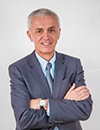
May 14th, 2019
Mr. Axel Krein (short CV here) share his thoughts on the occasion of taking on the role of Executive Director of Clean Sky 2 Joint Undertaking and on his perspective regarding the role of academia in CS 2 and the future of Aeronautics sector in Europe in general.
Since February 1st, 2019 you are Clean Sky Executive Director: What is your experience so far?
I am very pleased to be joining Clean Sky right now. The running Clean Sky 2 Program is well on the way towards delivering cutting-edge research on greener aviation, and right now, we are starting to prepare the path towards a new Clean Sky within Horizon Europe.
I am very confident that Clean Sky will offer solutions to significantly reduce the environmental footprint of aviation and help the European Union to lead global efforts to combat climate change.
Half way through the Clean Sky 2 programme, we are delivering on our ambitious objectives. The numbers speak for themselves: After preliminary results from the assessment of the 9th Call for Proposals, I am glad to report 1477 participations, representing 334 bigger industrial organisations, 420 small and medium enterprises, 373 research centres, and 350 universities from 28 different countries participating as Partners in Clean Sky 2.
What are the main challenges ahead and what will be your priorities in the months to come?
Research and innovation in aeronautics are crucial for Europe, and European Public-Private Partnerships are proven catalysts for delivering innovative technological results. The success of the original Clean Sky and its successor, Clean Sky 2, lies in the collaboration of engineers and scientists from all across Europe. In this regard, I would also like to mention the excellent co-operation of representatives from the European Institutions, members of the Governing Board, the EU Member States Representative Group and the Scientific Committee, all of whom provide input and guidance to facilitate our plans and actions.
A priority in the coming months will be to support the development of a new research program for aviation within Horizon Europe. This will involve all current Clean Sky stakeholders and also other highly-skilled European partners. The task is clear: continue to meet the demand for air transport, which is expected to grow at a pace of ~4% per annum worldwide, while at the same time limiting aviation?s impact on climate change.
The next Clean Sky Programme will have a strong focus on developing, maturing and finally demonstrating technologies with a significant decarbonisation impact on air vehicle operations. It is worth mentioning that new aircraft, incorporating Clean Sky technologies, will have to start entering into service from 2030 to 2035 in order to make a meaningful contribution to the Paris Agreement for combating climate change. Calculating backwards highlights, that we do have a burning platform for technology development right now!
Could you share with us some examples of Clean Sky 2 delivery?
A great number of examples of how Clean Sky 2 is currently delivering on our ambitious objectives of reducing CO2 emissions and noise levels in aircraft are now available. The following projects and many more, were presented by the project coordinators at our two-day Clean Sky conference in Brussels on April 9th & 10th: